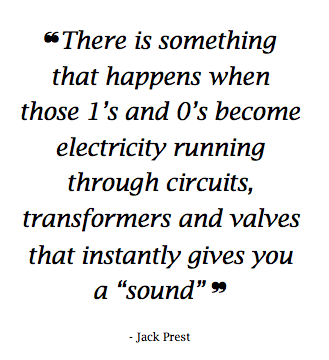Analogue Vs Digital Part 1 – Custom 75 Console Demo
To book Jack for your next project, contact Danielle on danielle@studios301.com or 02 9698 5888
The analogue versus digital debate is always sure to draw some strong opinions. On the one hand champions of the old school will wax lyrical about the magic of analogue equipment and tape recording, while the new wave of ITB (In The Box for the uninitiated) producers and engineers love the control and clarity, not to mention the convenience of computer based production. Over the next two blog posts I will be exploring this concept first through the comparison of an ITB versus an analogue summed mix and second comparing analogue synths and drum machines against their software emulations.
With a background in electronic music, I built my mixing chops in the software domain, it wasn’t until I began working for Studios 301 that I got exposed to top flight consoles and the hardware versions of the software I was using everyday. For me the benefits of the analogue equipment were undeniable, if somewhat unquantifiable. There is something that happens when those 1’s and 0’s become electricity running through circuits, transformers and valves that instantly gives you a “sound”. That said when working on some music (especially electronic based production) I would miss the definition and separation found when working ITB.
Recently 301 acquired one of the new Custom 75 Consoles powered by Neve for our Studio 6 and it has quickly become my favourite console at the studios. It’s unique design of having a modern (SSL-style) and retro (1073 era Neve) signal paths switchable on every channel and the output bus, give you the necessary control over how much analogue goodness you want to add to your mix. This console will be the test subject for this demo (please comment if you are interested in seeing similar demo’s with the other Studios 301 consoles).
To demonstrate what this console can do (and the benefits of analogue summing) I have done 4 bounces of the same ITB mix. The first is an internal bounce straight out of Pro-Tools. The other 3 are all summed through the Custom 75 as a set of 18 stereo pairs, with drums, basses, vocals, keyboards etc grouped together. All channel faders on the Neve are set to zero with the master fader set to drive the board in it’s sweet spot. The first summed bounce is using the modern signal path on all channels and the master bus, the second is modern signal path on all channels and retro on the output and the third is retro on all the channels and output. They have all been level matched and the edited together to each play the same 8 bars moving from ITB then the 3 summed mixes in order, then returning to the ITB mix. Make sure you listen on a nice set of speakers or headphones that you are used to.
When listening to the analogue summed mixes the first thing I notice is the instant widening of the mix, I can also place every element of the mix more easily in it’s own space. I also find the mid-range and upper mids lose the slight harshness found in the ITB mix and take on a more pleasing glassy quality. My favourite part is it adds serious weight and depth to the low-mids and bottom end. When switching in the retro bus you will notice the mix glues together ever so slightly just taking the smallest amount of transients (listen especially to the snare) or air pulling all the elements together.
Then with the retro signal path engaged on all channels you hear the familiar thickness and Neve magic throughout the entire mix (these changes are far more subtle than the comparison to ITB so you will need to listen close). Personally my favourite way to use this board is completely in modern mode. It gives me that extra width, definition and depth without compromising the clarity of my ITB mix, which IMHO makes it the perfect console for mixing and summing electronic music.
Given the clear benefits of the analogue summing in this instance, this would appear to be a win for the analogue side. However, don’t forget that this is simply summing a mix that was completed entirely ITB. Given the amount of processing used I would have needed 3 times the hardware in our biggest studios, hours of painstaking tape editing not to mentioned processes like Auto-Tune and Vocalign that were virtually impossible in the analogue realm (I have heard stories about people tuning vocals with an Eventide harmanizor but I for one am glad I will never have to do that). Add to that the time it would have taken just for me to recall this mix for this demo and things are starting to look a little more even.
For me this highlights the key point when talking about analogue versus digital in the recording and mix realm, it’s not about one or the other it’s about taking the best from both worlds to achieve the best result you can.
READ PART 2 HERE
[Written by Jack Prest who is an In-house Producer/Engineer at Studios 301]
To book Jack for your next project, contact Danielle on danielle@studios301.com or 02 9698 5888

Leave a Reply